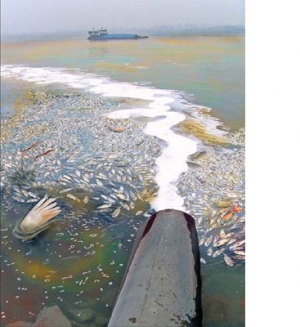Fast Fashion: Environmental and social impact
Submitted by Elizabeth DeHaan on | Updated Wed, 25/10/2017 - 16:33

For years, my favorite store has been Forever 21. Low prices and cute trendy clothing appealed to me. As a young adult, I could only afford clothes at bargain prices and didn’t give much thought into making an investment in terms of what I put on my body. I soon fell in love with H&M. A store who’s clothing was also cheap and trendy. They carried more professional clothing which worked as I was in college and needing clothes for interviews. Fast forward and I now have a closet of clothes made entirely out of synthetic fibers.
Retailers such as Forever 21 and H&M are known in the industry as fast fashion because of their ability to turnover new items very quickly. The clothes are cheaply made thus they are able to charge next to nothing. So as consumers, we feel like we are able to buy a lot but in actuality the price of cheap fashion is quite high.
Fifty percent of all clothing is now made from polyester. It’s the number one material found in our closets. Polyester is a synthetic fabric made from plastic. The most common form being PET, which is made from crude oil. This is the same plastic that is used in soda bottles. It’s then melted and spun into the fabric that we all know as polyester.1
Our love for Fast Fashion has caused the demand for all fibers to increase. And while natural fibers are the best, the supply cannot meet the demand. This lack of supply has caused annual production of polyester to increase from 5.8 tons in 1980 to 30.9 tons by 2007. Producing polyester requires a high amount of energy which uses fuel contributing to high emissions of carbon dioxide. The clothing industry releases 2.1 million tons of carbon dioxide every year which amounts to 10% of all carbon pollution.2
While the production of polyester is bad enough, the real problem is our consumption of clothing. 150 billion units of clothing are made every year. Fast Fashion has created a cycle of consumption and discarding. On average, we only wear each article of clothing 7 times before we give it away or find other ways to dispose of it. So we buy a lot of clothes and dispose of it very quickly, thus filling up landfills with our clothing. Polyester is not biodegradable. It takes 200 years for polyester to break down which is why we now have landfills full of clothing that cannot be disposed of.
The Benefits of Organic Clothing
Polyester is not the only fabric that is harming the environment. The use of pesticides in the production of cotton is also causing negative effects to the environment. Globally, the cotton industry uses 22.5% of all insecticides and 10% of all pesticides. For every pound of clothing produced, 0.02 pounds of pesticides are used. The Environmental Protection Agency classifies these as some of the most toxic chemicals used.3 These chemicals have been linked to brain, fetal damage, and sterility in humans. Many of the major countries where cotton is produced such as Uzbekistan, Brazil, and the region of West Africa have detected traces of these pesticides in the water. This same water is used for daily tasks by the people of these countries, such as drinking, cooking, and bathing.
Not only does Fast Fashion create harmful environmental effects through the use of fabrics, it also is destroying the environment through the use of dyes. Apparel is responsible for a whopping 20% of fresh water pollution.4 These dyes are not only harmful to people and wildlife but they are harmful to the environment. In the factories themselves, the workers are exposed to harmful chemicals. These chemicals include toxic phthalates and amines used in particular dyes. Chemicals like these, have been known to disrupt hormones and have been linked to miscarriages in women, birth defects, and cancer. 5
In China, where many garment factories are located, it’s estimated that a third of the country’s rivers are too polluted for human contact.3 In other countries such as India, the dyes used to make leather products such as sneakers run off into the river and not only are toxic to the environment but to the people who still have to use these rivers for water.
With more backlash coming out about how harmful the fashion industry is, some retailers are trying to do what they can to change their carbon footprint. H&M has started their recycling program. At any location you can bring in any article of clothing that you want to donate and they turn it into recycled fabrics such as lyocell. It’s a small step in discovering ways to recycle all of the clothing that we no longer want. It’s estimated that one pound of recycled clothing can reduce up to 8 lbs of C02 emissions.
What Can We Do: Ways to Support Sustainable Fashion
There are simple ways that we can do to combat the problem of fast fashion and become responsible consumers.
-
Check the tags on our clothing. Look for natural fibers such as organic cotton, wool, silk, and linen. Yes, the cost will be more but the quality of the clothing will be better and will last longer. These fabrics are also able to breathe more on your body so you will feel better when you’re wearing them. Once you decide to give these clothes away, they will be in better shape to be sold or donated. If they do end up in a land fill, you can rest assured that it will not take 200 years for them to decompose. Organic cotton is a better alternative than regular cotton because of the way it is produced. Organic cotton is grown using methods and materials that have less of an impact on the environment as well as the people involved in production. Organic cotton produces 3.8 pounds of CO2 emissions while regular cotton produces 5.9 pounds of CO2 emissions. 6
-
Start thinking of your clothing as an investment. We tend to think of our role in shopping as consumers. The definition of consume is to use up. So it makes sense that we think of our clothing as disposable, especially if you pay so little for it. If you begin to think of your clothing as an investment, it will change the quality of the clothing you are willing to buy. Worldwide, the fashion industry makes 1.2 trillion dollars annually, based on our shopping habits. If we begin to show companies that we demand higher quality clothing, they will be forced to make changes.
-
Support companies that produce sustainable fashion. There are several clothing companies that are making clothes that have been produced without using harmful dyes, with natural fibers, and protecting the interests of their workers. I will list two that I have personally seen their clothes and can vouch for.:
-
Recycle your clothing: Shop Used & Vintage Clothing - Vintage shopping is a great solution to fast fashion because you are recycling existing clothes instead of using new resources. Vintage shops also tend to have better quality clothing at a lower price. There are also more unique options since it’s not found in a typical store with mass production. By reusing clothes, 3-4 lbs of CO2 are saved for every pound of clothing that is not disposed of. 2 Over time, this would have a drastic effect on the amount of CO2 emissions released into the atmosphere.
-
Learn More: There are several ways that we can learn more information about the fashion industry and the impact that we have.
The book Overdressed by Elizabeth L. Cline, is a fascinating read about Fast Fashion vs. Slow Fashion. I first read it a few years ago and recently gave it to a friend who also loved it! It really goes in depth about the way that the fashion industry has changed and also offers practical solutions such as mending your clothes and going to a cobbler to repair shoes.
I would also recommend watching True Cost. It’s a documentary on Netflix that really examines the fashion industry and its impact as a global enterprise. For me this documentary, was a true eye opener into what is happening worldwide and how we play a part.
Fashion is something that we all partake in, whether it means a lot to us or not. By making conscious decisions and becoming aware of the issues we can begin to change the conversation.
Happy Shopping!!!
-
Bain, Marc. “If Your Clothes Aren’t Already Made Out of Plastic, They Will Be”, QZ.com. 21 June, 2016 < http://qz.com/414223/if-your-clothes-arent-already-made-out-of-plastic-they-will-be/ >
-
“ The Business of Fast Fashion” onlinemba.com 21 June, 2016 http://www.onlinemba.com/blog/business-of-fast-fashion/
-
Bain, Marc. “These Chinese Mills are Going Green- and Saving Millions’, QZ.com. 21 June,2016 < http://qz.com/383562/these-chinese-textile-mills-are-going-green-and-saving-millions/
-
“What we do for the Environment/ Recycling Textiles” planetaid.org, 21 June, 2016. < http://www.planetaid.org/what-we-do/for-the-environment/recycling-textiles>
-
Krupnick, Ellie. “Chemicals in the Fast Fashion Revealed in Greenpeace’s ‘Toxic Threads: The Big Fashion Stitch-Up’ huffingtonpost.com, 29. Nov. 2012 21 June, 2016 < http://www.huffingtonpost.com/2012/11/20/chemicals-in-fast-fashion-greenpeace-toxic-thread_n_2166189.html >
-
“Climate Change and the Textile Industry” oecotextiles.wordpress.com 21 June 2016 < https://oecotextiles.wordpress.com/tag/organic-cotton/ >
You will save the Earth by sharing and/or tweeting (corny right?)





